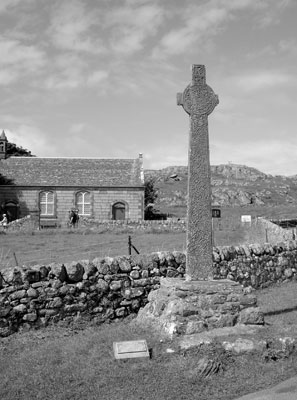Rick Steves' Europe » Mull and Iona: Scotland’s rugged Western Isles
by Rick Steves
For a memorable day in Scotland, visit two of its most scenic islands: Mull and Iona. Part of the historic Hebrides, they lie on Scotland’s west coast and make an easy day-trip from the seaside town of Oban. Hop on an early-morning Caledonian MacBrayne ferry from Oban to the Isle of Mull. After sightseeing Mull, you sail across gray waters on a second, smaller ferry before eventually landing on Iona’s stark, windswept shore.
Bowman’s Tours, located near Oban’s dock, sells tickets that include ferry crossings and the bus trip across Mull and back (allow about $50). The region has cold, wet, windy winters and mild, wet, windy summers. Bring plenty of rain protection and wear layers in case the sun peeks through the clouds.
The Isle of Mull, the third-largest in Scotland, has 300 miles of coastline and castles and a 3,169-foot-high mountain. Called Ben More (translated as “big hill” in the Gaelic language), it was once much bigger. The last active volcano in Northern Europe, it was 10,000 feet tall — and covered the entire island of Mull — before it blew. It’s calmer now and, similarly, Mull has a notably laid-back population. Locals say there are no deaths from stress and only a few from boredom.
With steep, fog-covered hillsides topped by ancient stone circles (sometimes indicating graves), Mull has a gloomy, otherworldly charm.
On the far side of Mull, the caravan of tour buses unloads at a tiny ferry town. The ferry takes about 200 walk-on passengers. Confirm clearly with the bus driver when to catch the boat off Iona for your return, then hustle off the bus (listening to your driver for the return time) and to the dock to avoid the 30-minute delay if you don’t make the first trip over.
After the 10-minute ride, you wash ashore on sleepy Iona. You’ll have about two hours here on your own before you retrace your steps. While the day is spectacular when it’s sunny, it’s worthwhile in any weather. The ferry mobs that crowded your steps seem to disappear into Iona’s back lanes.
The tiny island of Iona, just three miles by 1.5 miles, is famous as the birthplace of Christianity in Scotland. St. Columba, an Irish scholar, soldier, priest and founder of monasteries, got into a small war over the possession of an illegally copied psalm book. Victorious but sickened by the bloodshed, Columba left Ireland, vowing never to return. According to legend, the first bit of land out of sight of his homeland was Iona. He stopped here in 563 and established the abbey.
Columba’s monastic community flourished, and Iona became the center of Celtic Christianity. Iona missionaries spread the gospel through Scotland and North England, while scholarly monks established Iona as a center of art and learning. The “Book of Kells” — perhaps the finest illustrated manuscript from “Dark Ages” Europe — was probably created on Iona in the eighth century. The island was so important that it was the burial place for ancient Scottish kings (including Shakespeare’s Macbeth) and even Scandinavian royalty.
Slowly the importance of Iona ebbed. Vikings massacred 68 monks in 806. Fearing more raids, the monks evacuated most of Iona’s treasures (including the “Book of Kells,” which is now in Dublin) to Ireland. Much later, with the Reformation, the abbey was abandoned and most of its finely carved crosses were destroyed. In the 17th century, locals used the abbey only as a handy quarry for other building projects. Its population peaked at about 500 in the 1800s.
But in our generation, a new religious community has given the abbey new life. The Iona community is an ecumenical gathering of men and women who seek new ways of living the Gospel in today’s world, with a focus on worship, justice and reconciliation.
A pristine light and a thoughtful peace pervade the stark, car-free island and its tiny community. While the present abbey, nunnery and graveyard go back to the 13th century, much of what you’ll see was rebuilt in the 19th century. It’s free to see the ruins and the graveyard, but the abbey itself has a small fee (about $5). It’s worth the cost just to sit in the stillness of its lovely interior courtyard.
But enjoy the entire island, with buoyant clouds bouncing playfully off distant bluffs and sparkling white-sand crescents. Sit for a while on one of Iona’s huge rocks. Looking out to sea, you’ll find it’s a perfect place to meditate — and to scheme about returning to this tranquil Scottish isle.
CORRECTION — A careful reader, Priscilla Bath, found an error in my February ’06 column. The article, “Off-Beat Switzerland,” as printed, said, “You can take these topless trains in eastern Switzerland (St. Moritz to Tirano, Chur to Aosta and Filisur to Preda) during the summer months.” It should have said, “These topless trains are limited to the Upper Engadine region (St. Moritz to Tirano, Chur to Arosa and Filisur to Preda) during the summer months.” The correct town name is Arosa (in Switzerland), not the Italian destination of Aosta. — R.S.
Rick Steves (425/771-8303 or www.ricksteves.com) is the host of the public-television series “Rick Steves’ Europe,” the moderator of the new public radio show “Travel with Rick Steves” and the author of 30 European travel guidebooks. For more on Mull and Iona, see “Rick Steves’ Great Britain 2006.”

